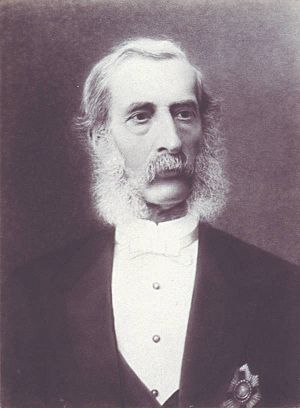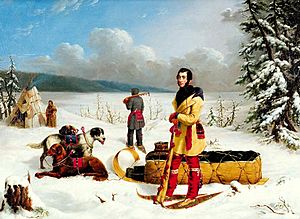John Henry Lefroy facts for kids
Sir John Henry Lefroy (born January 28, 1817 – died April 11, 1890) was an English officer in the army. He was also a colonial administrator, which means he helped govern British lands far from England. But he was most famous for his amazing scientific work studying the Earth's magnetism.
Contents
A Life of Science and Adventure
John Henry Lefroy was born in England. From a young age, he showed a talent for science. In 1831, when he was 14, he joined the Royal Military Academy, Woolwich in London. By 1834, he became a second lieutenant in the Royal Artillery.
Studying Earth's Magnetism
The British government started a big project to study the Earth's magnetic field. This invisible force makes compasses point north and protects our planet from space radiation. Lefroy was chosen to help with this important work.
In 1839, he sailed to Saint Helena, an island in the Atlantic Ocean. There, he set up and managed an observatory. This was a special building where scientists could make careful measurements of the Earth's magnetism.
Exploring Canada's Wilds
In 1842, Lefroy was sent to Toronto, Canada. He became the leader of a new observatory there, built for the same magnetic study. He quickly planned a huge trip into the Canadian wilderness.
From May 1843 to November 1844, Lefroy traveled more than 5,000 miles across the Northwest. He had an assistant and help from the Hudson's Bay Company. They took measurements at over 300 different spots! His goal was to map the Earth's magnetic activity across British North America. He even tried to find the exact location of the North Magnetic Pole.
They explored far-off places like the Mackenzie River and visited Fort Good Hope and Fort Simpson. For his amazing scientific work, Lefroy became a member of the Royal Society in 1848. This is a very old and respected group of scientists.
Life in Toronto
Lefroy stayed in Toronto until 1853. He continued his observations and managed the observatory. In 1846, he married Emily Mary. They had four children together.
He also helped start the Royal Canadian Institute, a group for scientists and scholars. He was its first vice-president and later its president. Before returning to England, he made sure the Toronto observatory would continue its work under the local government.
Back in England
When Lefroy returned to London in 1853, he took on different jobs in the British Army. He helped make changes to the army. He even wrote letters to Florence Nightingale, a famous nurse, about army reforms.
Later, he became the Inspector General of army schools. In 1868, he became the director of the Ordnance Office, which managed military supplies. After his first wife passed away, he married Charlotte Anna in 1860.
Governor and Administrator
In 1870, Lefroy retired from the army as an honorary Major General. He then joined the Colonial Service. This meant he would help govern British colonies.
From 1871 to 1877, he was the Governor of Bermuda. This was a very important job because Bermuda was a key British naval and military base. He had to leave this position due to illness. Later, from 1880 to 1881, he served as the Administrator of Tasmania, an island south of Australia.
John Henry Lefroy was honored for his service. He received the Order of the Bath in 1870 and was knighted in 1877. This meant he was called "Sir John."
Lasting Legacy
Sir John Henry Lefroy left his mark in many ways.
Places Named After Him
- A small town in Ontario, Canada, called Lefroy, is named after him. It's located on the south end of Lake Simcoe.
- Mount Lefroy in the Rocky Mountains is also named in his honor.
A Famous Painting
A famous painting by Paul Kane shows John Henry Lefroy. It's sometimes called Scene in the Northwest: Portrait of John Henry Lefroy. This painting was once owned by Lefroy's family in England. In 2002, it was sold at an auction for over C$5 million (Canadian dollars)! A Canadian billionaire named Kenneth Thomson bought it. He later gave the painting to the Art Gallery of Ontario so everyone could see it.
Honoring His Work
In 1960, a special plaque was put up on the University of Toronto campus. It honors Sir John Lefroy and his important work:
Sir John Henry Lefroy 1817–1890: A pioneer in the study of terrestrial magnetism, Lefroy was director of the magnetic observatory here from 1842 to 1853. Born in Hampshire, England, he was commissioned in the Royal Artillery at the age of seventeen and, because of his aptitude for science, was posted to St. Helena in 1839 to establish a magnetic observatory. Three years later he was transferred to Toronto. During 1843–44 Lefroy conducted the first comprehensive magnetic and meteorological survey in British North America, making observations of exceptional scope and scientific value. Before returning to England in 1853 he was instrumental in persuading the provincial government to assume responsibility for the observatory. Following a distinguished career as a soldier, scholar and colonial administrator, Lefroy was knighted in 1877.



